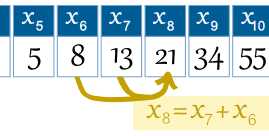The Fibonacci Sequence is the series of numbers:
0, 1, 1, 2, 3, 5, 8, 13, 21, 34, ...
The next number is found by adding up the two numbers before it.
The 2 is found by adding the two numbers before it (1+1)
The 3 is found by adding the two numbers before it (1+2),
And the 5 is (2+3),
and so on!
Example: the next number in the sequence above is 21+34 = 55
It is that simple!
Here is a longer list:
0, 1, 1, 2, 3, 5, 8, 13, 21, 34, 55, 89, 144, 233, 377, 610, 987, 1597, 2584, 4181, 6765, 10946, 17711, 28657, 46368, 75025, 121393, 196418, 317811, ...
Can you figure out the next few numbers?
Makes A Spiral
When we make squares with those widths, we get a nice spiral:

Do you see how the squares fit neatly together?
For example 5 and 8 make 13, 8 and 13 make 21, and so on.

This spiral is found in nature!
The Rule
The Fibonacci Sequence can be written as a "Rule" (see Sequences and Series).
First, the terms are numbered from 0 onwards like this:
n = 0 1 2 3 4 5 6 7 8 9 10 11 12 13 14 ...
xn = 0 1 1 2 3 5 8 13 21 34 55 89 144 233 377 ...
So term number 6 is called x6 (which equals 8).
Example: the 8th term is
the 7th term plus the 6th term:
x8 = x7 + x6

So we can write the rule:
The Rule is xn = xn-1 + xn-2
where:
xn is term number "n"
xn-1 is the previous term (n-1)
xn-2 is the term before that (n-2)
Example: term 9 is calculated like this:
x9= x9-1 + x9-2
= x8 + x7
= 21 + 13
= 34
Golden Ratio

And here is a surprise. When we take any two successive (one after the other) Fibonacci Numbers, their ratio is very close to the Golden Ratio"φ" which is approximately 1.618034...
In fact, the bigger the pair of Fibonacci Numbers, the closer the approximation. Let us try a few:
A
B
B / A
2
3 1.5
3
5 1.666666666...
5
8 1.6
8
13 1.625
...
... ...
144
233 1.618055556...
233
377 1.618025751...
Note: this also works when we pick two random whole numbers to begin the sequence, such as 192 and 16 (we get the sequence 192, 16, 208, 224, 432, 656, 1088, 1744, 2832, 4576, 7408, 11984, 19392, 31376, ...):
A
B
B / A
192
16 0.08333333...
16
208 13
208
224 1.07692308...
224
432 1.92857143...
7408
11984 1.61771058...
11984
19392 1.61815754...
It takes longer to get good values, but it shows that not just the Fibonacci Sequence can do this!
Using The Golden Ratio to Calculate Fibonacci Numbers
And even more surprising is that we can calculate any Fibonacci Number using the Golden Ratio:

The answer always comes out as a whole number, exactly equal to the addition of the previous two terms.
Example:

When I used a calculator on this (only entering the Golden Ratio to 6 decimal places) I got the answer 8.00000033. A more accurate calculation would be closer to 8.
Try it for yourself!
Some Interesting Things
Here is the Fibonacci sequence again:
n = 0 1 2 3 4 5 6 7 8 9 10 11 12 13 14 15 ...
xn = 0 1 1 2 3 5 8 13 21 34 55 89 144 233 377 610 ...
There is an interesting pattern:
Look at the number x3 = 2. Every 3rd number is a multiple of 2 (2, 8, 34, 144, 610, ...)
Look at the number x4 = 3. Every 4th number is a multiple of 3 (3, 21, 144, ...)
Look at the number x5 = 5. Every 5th number is a multiple of 5 (5, 55, 610, ...)
And so on (every nth number is a multiple of xn).
1/89 = 0.011235955056179775...
Notice the first few digits (0,1,1,2,3,5) are the Fibonacci sequence?
In a way they all are, except multiple digit numbers (13, 21, etc) overlap, like this:
0.0
0.01
0.001
0.0002
0.00003
0.000005
0.0000008
0.00000013
0.000000021
... etc ...
0.011235955056179775... = 1/89
Terms Below Zero
The sequence works below zero also, like this:
n = ... -6 -5 -4 -3 -2 -1 0 1 2 3 4 5 6 ...
xn = ... -8 5 -3 2 -1 1 0 1 1 2 3 5 8 ...
(Prove to yourself that each number is found by adding up the two numbers before it!)
In fact the sequence below zero has the same numbers as the sequence above zero, except they follow a +-+- ... pattern. It can be written like this:
x−n = (−1)n+1 xn
Which says that term "-n" is equal to (−1)n+1 times term "n", and the value (−1)n+1 neatly makes the correct 1,-1,1,-1,... pattern.

